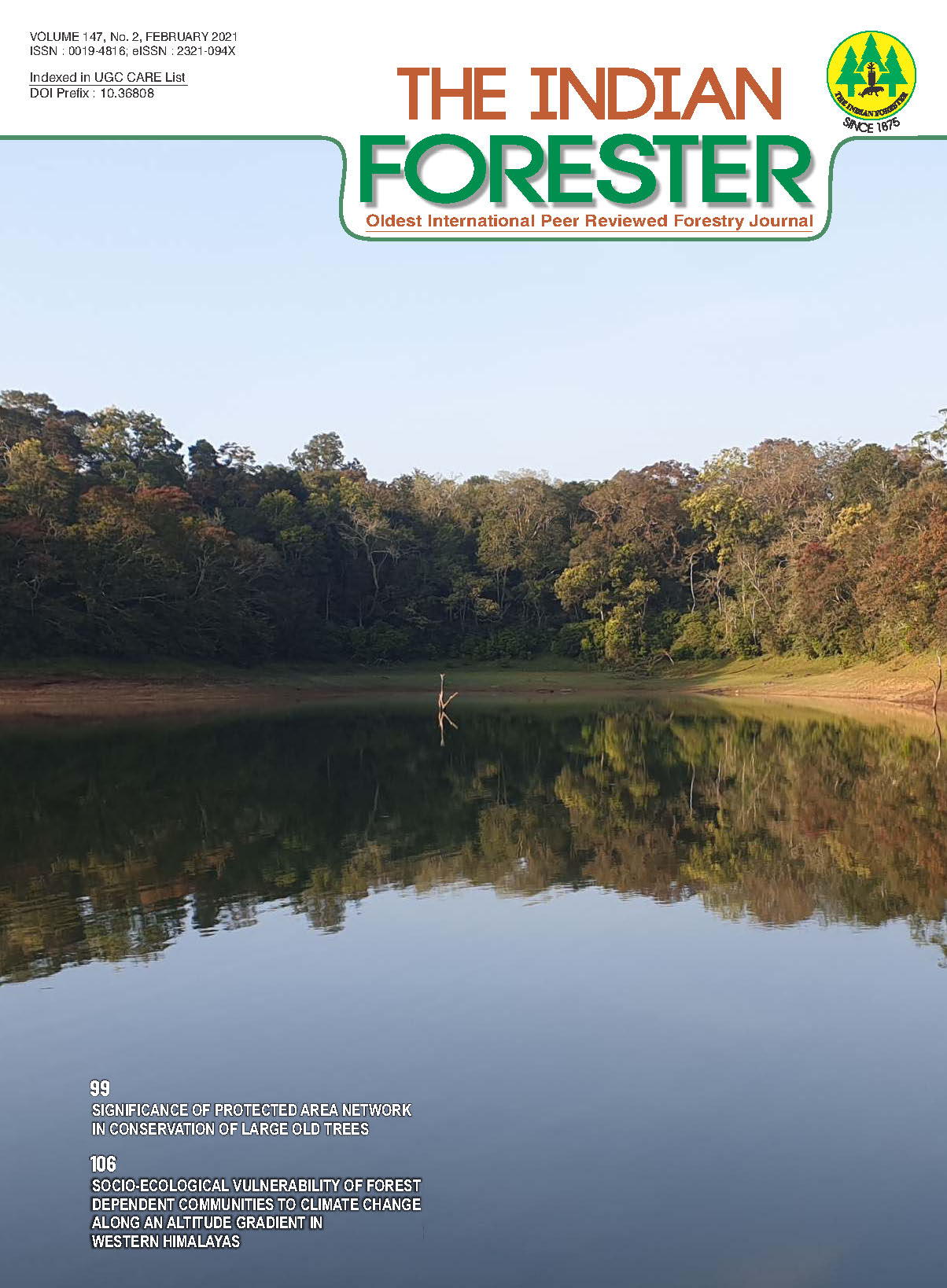Studies on Threat Status of Tree species of Madhya Pradesh, India
DOI:
https://doi.org/10.36808/if/2021/v147i2/155043Keywords:
Tree Species, Threat Status, Madhya Pradesh, India.Abstract
The present paper deals with the threat status of tree species of Madhya Pradesh as per IUCN criteria version 3.1 (2001). A total number of 40 species belonging to 24 families are reported under various threatened categories of IUCN in the present work. Out of 40 threatened species, 2 species are 'Critically Endangered', 6 species 'Endangered', 11 species 'Vulnerable' and 21 species 'Near Threatened'. The causes of threat have been discussed, and it has been observed that habitat loss due to various factors is the major cause of threat followed by unsustainable harvesting, lack of pollinators, diseases, edaphic factors and economic activities.References
CBD (1992). The Convention on Biological Diversity. https://www.cbd.int/convention/.
Champion H.G. and Seth S.K. (1968). A Revised Survey of the Forest Types of India. Manager of Publications, Delhi.
Făgăras M., Anastasiu P. and Gavril N. (2010). Rare and threatened plants in the Black Sea coastal area between Cape Midia (Romania) and Cape Kaliakra (Bulgaria). Botanica Serbica, 34(1): 37-43.
Fernando E.S., Co L.C., Lagunzad D.A., Gruezo W. Sm., Barcelona J.F., Madulid D.A., Lapis A.B., Texon G.I., Manila A.C. and Zamora P.M. (2008). Threatened plants of the Philippines: A preliminary assessment. Asia Life Sciences Supplement, 3: 1-52.
Gardenfors U., Taylor C.U., Mace G. M. and Rodriguez J.P. (2001). The application of IUCN red list criteria at regional levels. Conservation Biology, 15: 1206-1212. DOI: 10.1046/j.1523-1739.2001.00112. x.
Hall A.V., De Winter M., De Winter B. and Van Oosterhout S.A.M. (1980). Threatened plants of Southern Africa. South African National Scientific Programmes Report No. 45. CSIR, Pretoria, South Africa.
Harun-ur-Rashid M., Rashid M.E. and Rahman M.A. (2014). Inventory of threatened plants of Bangladesh and their conservation management. Intern. J. Environment, 3(1): 141-167.
Hilton-Taylor C. (2000). The IUCN Red List of Threatened Species. IUCN, Gland, Switzerland and Cambridge, UK.
Hunter M.L. and Hutchinson A. (1994). The virtues and shortcomings of parochialism: conserving species that are locally rare, but globally common. Conservation Biology, 8: 1163-1165. DOI:10.1046/j.15231739.1994.08041163. x.
Hussain S.S., Ahmad M., Siddiqui M.F. and Wahab M. (2010). Threatened and Endangered Native plants of Karachi. Intern. J. Biol. Biotech., 7(3): 259-266.
IUCN (2001). 2001 IUCN Red List Categories and Criteria (Version 3.1). https://iucn-csg.org/red-list-categories/.
Jaffre T., Bouchet P. and Veillon J. (1998). Threatened plants of New Caledonia: Is the system of protected areas adequate? Biodiversity and Conservation, 7: 109-135.
Jain S.K. and Rao R.R. (eds.) (1983). An Assessment of Threatened Plants of India. Botanical Survey of India, Calcutta.
Jain S.K. and Sastry A.R.K. (1983). Materials for a Catalogue of Threatened Plants of India. Botanical Survey of India, Calcutta.
Khanna K.K., Diwanji V.B., Sikarwar R.L.S., Dubey P.C. and Tiwari A.P. (2013). Madhya Pradesh ke Pramukh Van Vriksh. Shiv Om Sai Prakashan, Indore, Madhya Pradesh.
Khanna K.K. and Kumar A. (2002). Recollection of an endemic plant, Ficus cupulata Haines from type locality (Pachmarhi Biosphere Reserve). Bull. Bot. Surv. India, 44 (1-4): 145-146.
Khanna K.K., Kumar A., Dixit R.D. and Singh N.P. (2001). Supplement to the Flora of Madhya Pradesh, Botanical Survey of India, Calcutta.
Lundberg P., Ranta E. and Kaitala V. (2000). Species loss leads to community closure. Ecology Letters, 3: 465-468. DOI: 10.1111/j.1461-0248.2000.00170.x.
Mudgal V., Khanna K.K. and Hajra P.K. (eds.) (1997). Flora of Madhya Pradesh, Vol-2, Botanical Survey of India, Calcutta.
Nayar M.P. and Sastry A.R.K. (eds.). (1987-1990). Red Data Book of Indian Plants Vol. 1, 2 & 3 Botanical Survey of India, Calcutta.
Pfab M.F. and Victor J.E. (2002). Threatened Plants of Gautong, South Africa. South African J. Botany, 68: 370-375.
Rao C.K., Geetha B.L. and Suresh G. (2003). Red List of Threatened Vascular Plant species in India. ENVIS Botanical Survey of India, Howrah.
Singh J.S. (2002). The biodiversity crisis: A multifaceted review. Current Science, 82(6): 638-647.
Singh N.P., Khanna K.K., Mudgal V. and Dixit R.D. (eds.) (2001). Flora of Madhya Pradesh, Vol. III, Botanical Survey of India, Calcutta.
Ved D.K., Kinhal G.A., Ravikumar K., Karnat Mohan, Vijaya Sankar R. and Indresha J.H. (eds.) (2003). Threat Assessment & Management Prioritisation for the Medicinal Plants of Chattisgarh & Madhya Pradesh, Foundation for Revitalization of Local Health Traditions, Bangalore, India.
Verma D.M., Balakrishnan N.P. and Dixit R.D. (eds.) (1993). Flora of Madhya Pradesh, Vol-1, Botanical Survey of India, Calcutta.
Walter K.S. and Gillett H.J. (eds.) (1998). 1997 IUCN Red List of Threatened Plants. Compiled by the World Conservation Monitoring Centre. IUCN-The World Conservation Union, Gland, Switzerland and Cambridge, U.K. 862 pp.
Walters S.M. (1976). The conservation of threatened vascular plants of Europe. Biological Conservation, 10(1): 31-41.
Ward D.B., Austin D.F. and Coile N.C. (2003). Endangered and Threatened Plants of Florida, Ranked in order of rarity. Castanea, 68: 160-174.
Zhang Z., He J., Li J. and Tang Z. (2015). Distribution and conservation of threatened plants in China. Biological Conservation, 192: 454-460.
Downloads
Downloads
Published
How to Cite
Issue
Section
License
Unless otherwise stated, copyright or similar rights in all materials presented on the site, including graphical images, are owned by Indian Forester.





